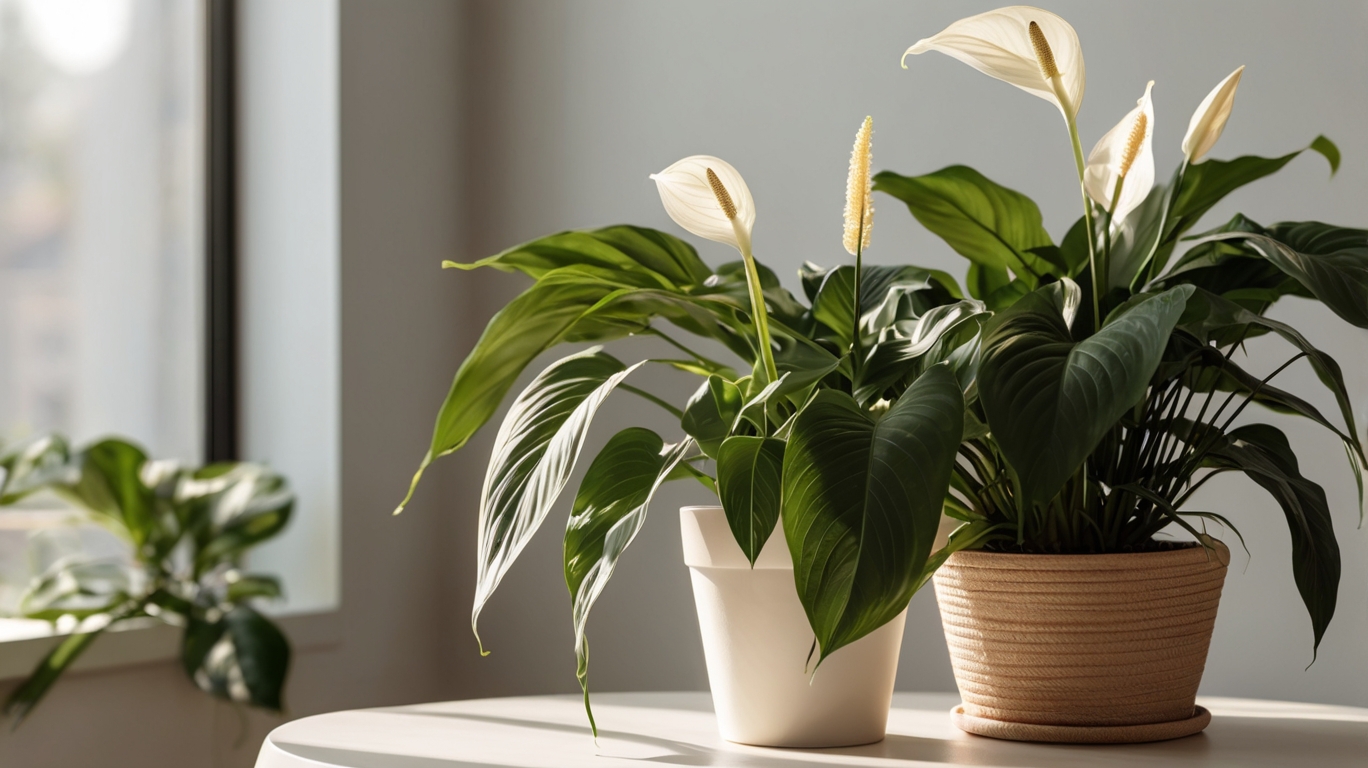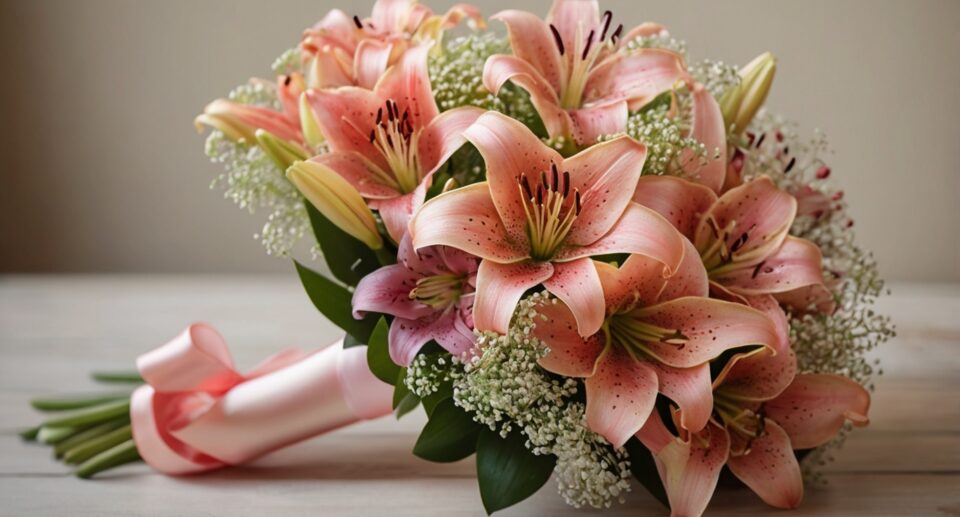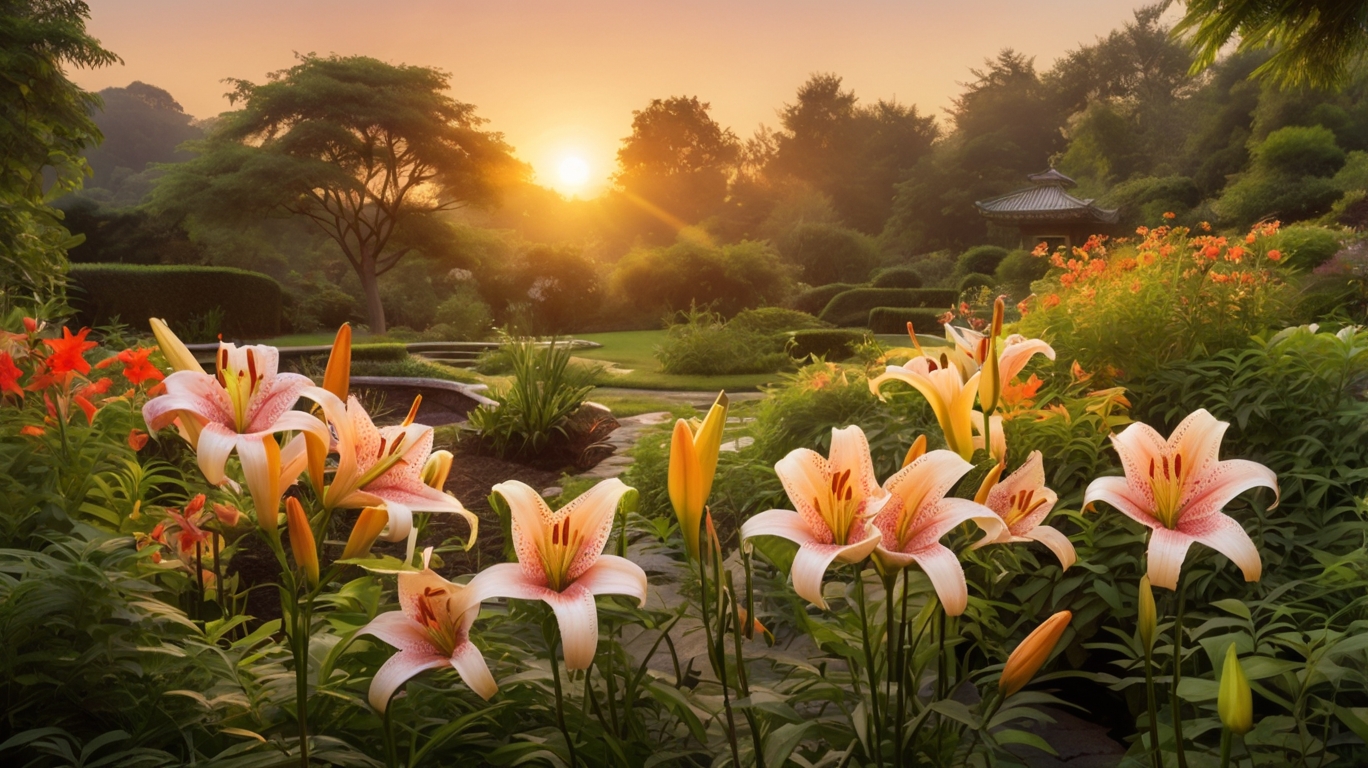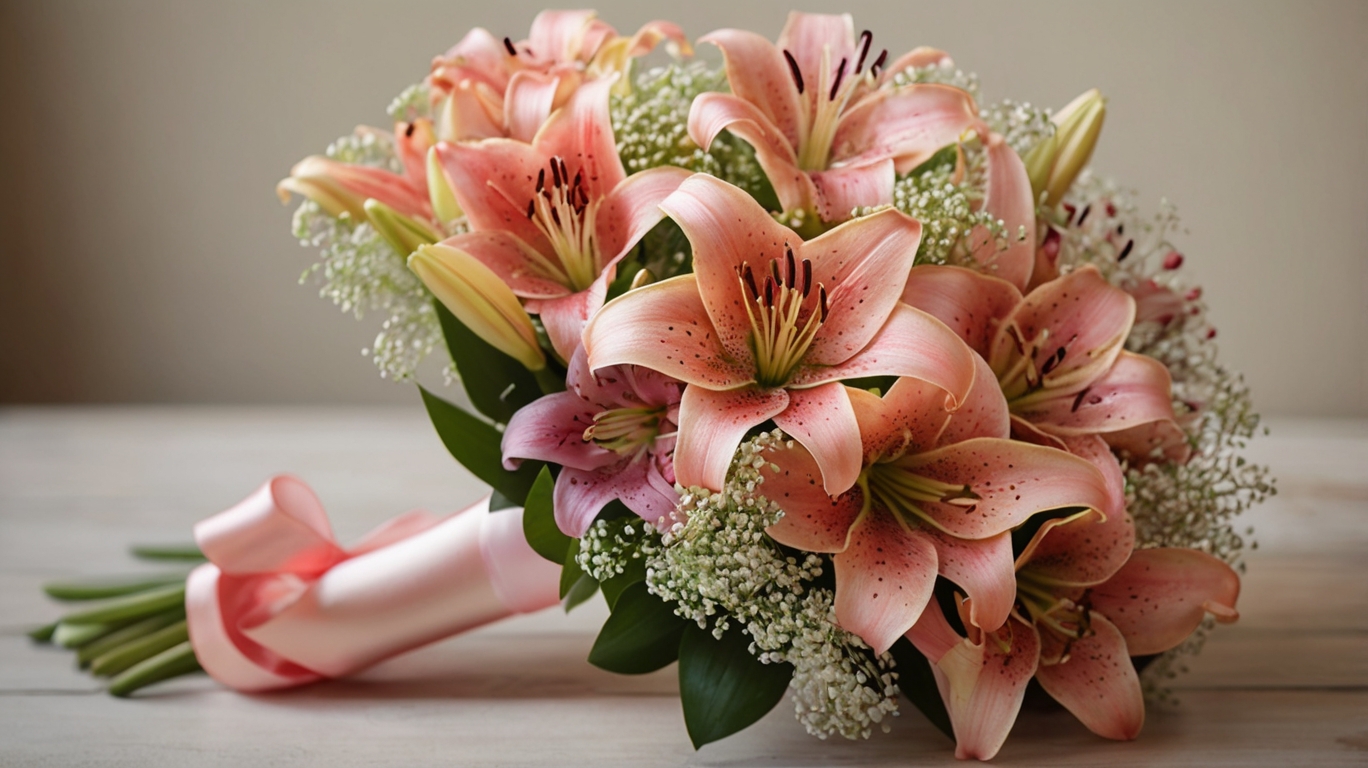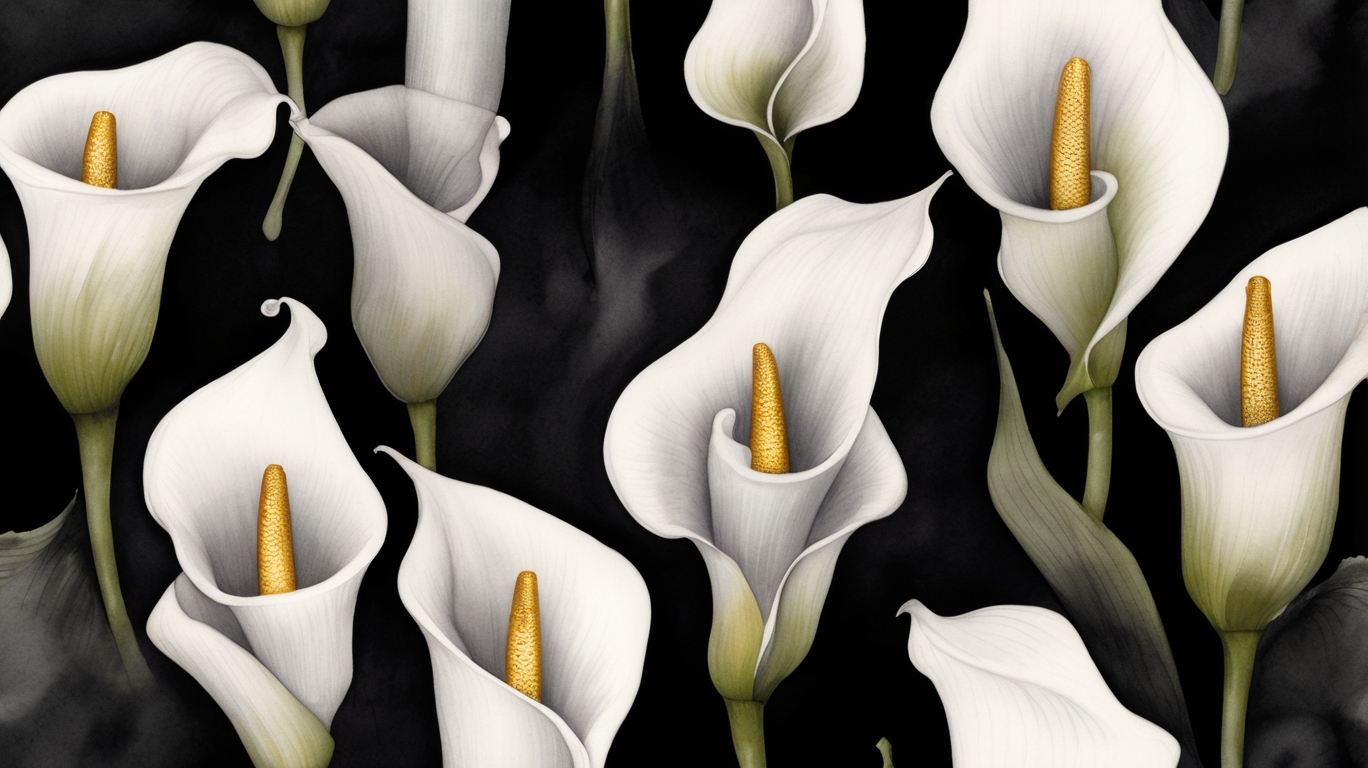When Does Lily Flower Bloom? Seasonal Guide #1 to Explained
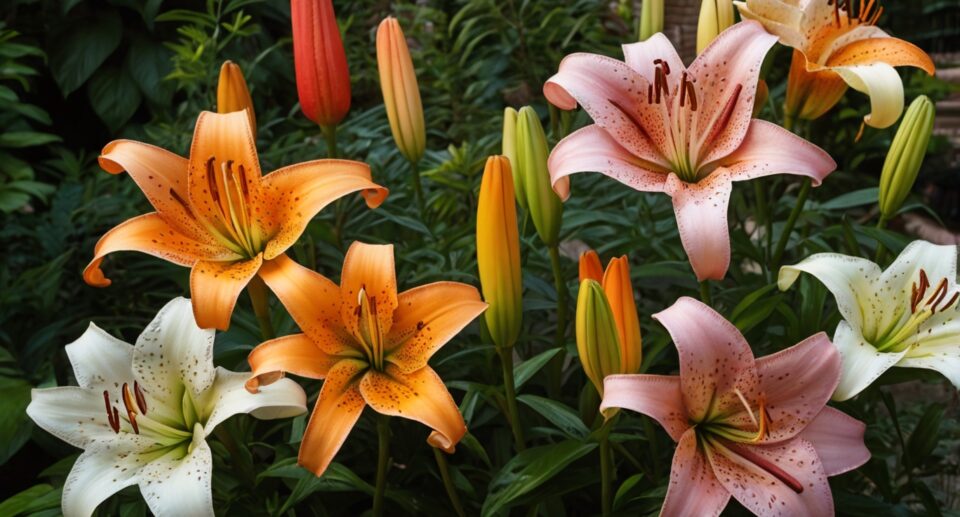
Introduction to Lily Flowers and Their Blooming Patterns
Lily flowers hold a distinguished position among ornamental plants due to their captivating beauty and wide variety of species. Belonging to the genus Lilium in the family Liliaceae, these perennial flowers are celebrated for their large, trumpet-shaped Blossom and vibrant colors that range from pure white to bright yellow, orange, pink, and deep red. Their prominence in gardens and floral arrangements can be attributed to their grace, fragrance, and adaptability to various environmental conditions.
Lily plants thrive in temperate regions, exhibiting diverse blooming tendencies based on their species and climatic preferences. Commonly, they are categorized into types such as Asiatic, Oriental, Trumpet, and Martagon lilies, each presenting unique Blossom characteristics. By understanding these variations, gardeners can cultivate lilies to align with seasonal conditions and regional climates effectively.
The blooming patterns of lilies depend heavily on factors such as sunlight availability, soil composition, and water distribution. Most lilies require a well-drained soil enriched with organic matter to support healthy growth and vibrant blooming. Furthermore, their flowering schedule often correlates with day length and temperature, making them sensitive to seasonal changes.
These flowers typically blossom from late spring to early fall, with variations occurring due to specific species traits. For example:
- Asiatic lilies tend to blossom earlier, usually starting in late spring.
- Oriental lilies are known for their midsummer to early autumn blossoms.
- Trumpet lilies often peak during midsummer.
- Martagon lilies favor early-to-mid summer for flowering.
Understanding these patterns helps in predicting their blossom cycles and enhancing garden designs. Careful maintenance, including fertilization and pruning, can prolong blooming periods and ensure the lilies remain vibrant throughout their season.
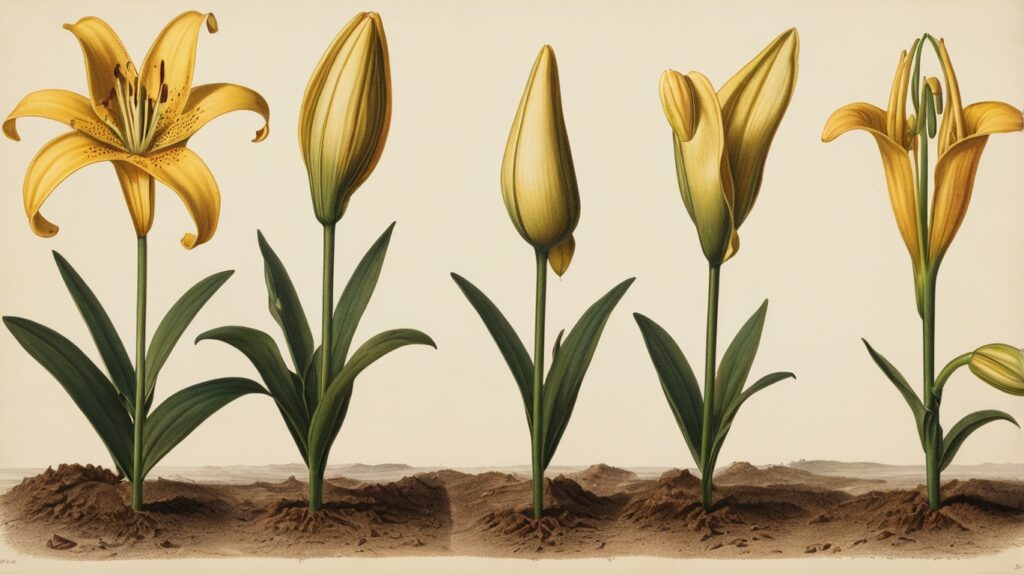
The Different Types of Lily Flowers and Their Unique Bloom Seasons
Lilies, belonging to the genus Lilium, showcase extraordinary diversity in their species, blossom schedules, and unique aesthetic appeal. Each variety has specific environmental preferences and distinct seasonal blooming patterns. Understanding these characteristics aids gardeners and flower enthusiasts in cultivating and appreciating these striking flowers.
- Asiatic Lilies: These are among the earliest bloomers, typically flowering from late spring to early summer. Known for bold, vibrant colors like orange, red, and yellow, Asiatic lilies are easy to grow and thrive in well-drained soil under full sun. They lack fragrance, making them an ideal choice for those sensitive to floral scents.
- Oriental Lilies: Oriental lilies blossom later in the season, from mid-to-late summer, offering a longer period of vibrant floral display. Characterized by large flowers with a sweet aroma, their shades of white, pink, and crimson bring elegance to gardens. These varieties prefer slightly acidic soil and require ample sunlight to achieve their full bloom potential.
- Martagon Lilies: Known as “Turk’s Cap Lilies,” Martagon lilies blossom in early summer. Their downward-facing, curled petals come in muted tones of orange, pink, and mauve. Adaptable to partial shade, they thrive in woodland or semi-shady garden environments.
- Trumpet Lilies: Recognizable by their large, trumpet-shaped flowers, these lilies blossom mid-summer. Their rich fragrance and elongated form make them a standout species. Trumpet lilies prefer warm climates with consistent sunlight exposure and well-nourished soil.
- Tiger Lilies: Tiger lilies are late bloomers, appearing in mid-to-late summer. Sporting bold orange petals with black spots, these lilies are highly resilient and can tolerate a wider range of growing conditions. Their striking visual appeal makes them popular in naturalized or perennial flower beds.
- Daylilies: Although not true lilies, daylilies are often grouped within this category due to their similar flower structure. Daylilies produce blossoms that last only one day, but their flowering period stretches across multiple months in summer. Available in a vast array of colors, they adapt effortlessly to various soil and sunlight conditions.
Lilies effectively harmonize their beauty with the seasons, making them a versatile and timeless addition to gardens worldwide. Whether thriving in full sunlight or shaded areas, each type offers distinctive splendor matched to its seasonal appearance.
Understanding the Role of Climate in Lily Flower Blooming
Climate plays a significant role in determining when lily flowers blossom, as these plants thrive under specific environmental conditions influenced by regional weather patterns. Lilies, known for their adaptability, are cultivated in various parts of the world, but their blooming schedule is largely dictated by the surrounding climate.
Temperature Preferences
Lilies favor moderate temperatures, with most varieties performing best in climates where daytime temperatures range between 65°F to 85°F. While they can tolerate cooler nights, frost can damage young buds or delay blooming. Tropical species, such as the Madonna lily, prefer warmer environments, while Asiatic and Oriental hybrids are better suited to temperate zones.
Sunlight Requirements
Adequate sunlight exposure is a critical factor in lily flower development. Most lily species require full sun, although some varieties, like Turk’s cap lilies, can thrive in partial shade. The intensity and duration of sunlight directly impact the plant’s photosynthesis process, which is essential for producing vibrant, healthy blossoms.
Soil Moisture and Rainfall
The amount of precipitation also affects blooming cycles. Lilies prefer well-draining soil with consistent moisture levels; drought can inhibit flowering, while overly waterlogged conditions may lead to bulb rot. In regions with seasonal rainfall, lilies often align their blooming periods with periods of moderate moisture.
Seasonal Patterns
In climates with distinct seasons, lilies typically synchronize their blooming cycles with spring or summer months when conditions become ideal for growth. However, in areas with year-round mild climates, certain varieties can blossoms at irregular intervals.
Regional climate variations create unique blooming timelines across different parts of the world. Understanding these climatic factors helps gardeners optimize planting schedules and ensure robust flowering. Climate remains a decisive element in the growth and blooming success of lily flowers.
Spring Blossoms: Lilies That Bloom in Early Seasons
Spring is a season of renewal, marked by the emergence of vibrant blossom, including some varieties of lilies. While many associate lilies with summer months, some species are known for their early flowering patterns, bringing beauty and color to gardens as the chill of winter fades. These spring-blooming lilies are particularly favored by gardeners seeking early bursts of elegance and fragrance in their landscaping.
Types of Spring-Blooming Lilies
Certain lily varieties are predisposed to blossom earlier in the season. Below are a few notable types that flower in spring:
- Asiatic Lilies: Among the earliest to blossom, Asiatic lilies are a popular choice for spring gardens. Known for their robustness, they display bright and bold colors without overwhelming fragrances. Gardeners often plant these varieties to kickstart the season with a vivid splash of color.
- Martagon Lilies: These unique lilies feature nodding bell-like flowers. They thrive in partially shaded environments, making them an excellent choice for woodland gardens. Typically flowering in late spring, they are celebrated for their elegant appearance.
- Trumpet Lilies: While primarily considered summer bloomers, certain trumpet lilies start flowering in mid to late spring. They are valued for their striking form and sizable blossoms with trumpet-shaped petals, adding grandeur to any early-season garden setting.
Environmental Factors That Influence Early Blooming
Growth and blossom cycles of lilies are often affected by specific climatic conditions. The onset of warmer temperatures, combined with increased daylight hours typical of spring, triggers the flowering process for these early-season varieties. Soil composition, drainage, and the amount of sunlight also play a pivotal role, as lilies require well-drained soil and optimal moisture to thrive.
Tips for Maximizing Spring Blooms
Ensuring vibrant spring flowers involves some essential care practices:
- Choose the Right Bulbs: Opt for bulbs labeled as early bloomers and ensure they are suited for the region’s climate.
- Plan for Adequate Sunlight: Early lilies flourish in sunny conditions, though some varieties tolerate partial shade.
- Protect from Late Frost: Spring weather can be unpredictable, and late frost can harm emerging lilies. Using mulch or temporary covers can help safeguard delicate plants.
Transitioning from winter into spring, these lilies provide an enchanting sight, marking the start of the flowering season with grace and charm.
Summer Lilies: Varieties That Peak in Warmer Months
Summer lilies are renowned for their vivid colors and captivating fragrances, offering a striking presence in gardens during their peak blooming season. These varieties thrive in the warmer months, typically reaching full blossom between late spring and midsummer, depending on the climate and planting conditions. Their ability to flourish in higher temperatures makes them a favorite choice for brightening up outdoor spaces during sunny seasons.
Popular Varieties of Summer Lilies
Several types of lilies exhibit their finest blossoms in summer, each showcasing unique characteristics. These varieties include:
- Asiatic Lilies Asiatic lilies stand out for their bold colors and upward-facing blossoms. They blossom earlier in the summer, featuring minimal fragrance but extraordinary hues like orange, red, yellow, and pink. These lilies are low-maintenance and adaptable to different growing conditions, making them popular in gardens.
- Trumpet Lilies Known for their elongated, tubular flowers, trumpet lilies blossom during midsummer and emit a rich, sweet scent. Their elegant blossoms come in shades of white, gold, and pastel pink, often adding sophistication to summer arrangements.
- Oriental Lilies Oriental lilies are prized for their large, exotic blossoms and intense fragrance. These varieties thrive in late summer, producing star-shaped flowers in a spectrum of colors, including crimson, white, and purple. Their strong aroma and dramatic appearance create a captivating garden focal point.
- Tiger Lilies Tiger lilies, identifiable by their spotted petals, flourish in midsummer. Their vibrant orange blossoms and tall stems add height and contrast to garden landscapes, making them highly desirable for summer floral displays.
Growth and Maintenance Insights
To ensure optimal blooming during the summer months, lilies require well-drained soil and ample access to sunlight. Gardeners are advised to water them regularly while avoiding excessive moisture that could lead to bulb rot. Mulching helps retain moisture and regulate soil temperature during peak heat, promoting healthy growth. Deadheading spent flowers redirects the plant’s energy toward producing new blossoms.
Block planting these varieties in complementary colors can result in stunning displays, while staggered planting ensures an extended blooming period. These lilies benefit from fertilization early in the growing season, but overfeeding should be avoided to prevent weaker stems or diminished flowers.
Fall Lilies: Late Blooming Types and Their Characteristics
Fall lilies captivate gardeners and flower enthusiasts with their ability to blossom during the late season, providing vibrant displays when other plants begin to fade. These late-blooming lilies often serve as the perfect bridge between summer and autumn, offering beauty and color to landscapes during cooler months. Several distinctive types and characteristics make these lilies particularly appealing.
Common Varieties of Fall-Blooming Lilies
- August Lily (Lilium formosanum): Known for its trumpet-shaped flowers, this lily blossoms in late summer and extends into early autumn. It is often characterized by its sweet fragrance and white petals, making it suitable for ornamental gardens.
- Tiger Lily (Lilium lancifolium): Recognizable by its spotted orange petals, this hardy lily flourishes in the late blooming season. Its ability to adapt to various soil conditions makes it a favorite among gardeners.
- Black Beauty Lily: This hybrid lily showcases rich, red-maroon petals with a striking green throat, often blooming in August and September. It exhibits a unique downward-facing form and adds dramatic flair to fall gardens.
Growth and Adaptability
Late-blooming lilies often possess traits that enable them to thrive in cooler, post-summer climates. They are typically more resistant to temperature fluctuations compared to earlier blooming types. Many varieties prefer well-drained soil with ample sunlight, although they can tolerate partial shade environments. Their robust nature allows them to be resilient against common pests late in the season.
Flowering Patterns and Appearance
Fall lilies vary in size and style, with some producing bold clusters of blossoms while others deliver single, elegant flowers. Many are highlighted by vibrant hues such as reds, oranges, and whites, which contrast beautifully against fading deciduous foliage. Their extended blooming timeline makes these lilies a valuable addition to autumn gardening landscapes.
Late-blooming lilies enrich fall gardens by combining resilience, adaptability, and charm, complementing seasonal transitions beautifully. They emphasize nature’s cycle of renewal, offering bursts of life when most flowering plants have completed their course.
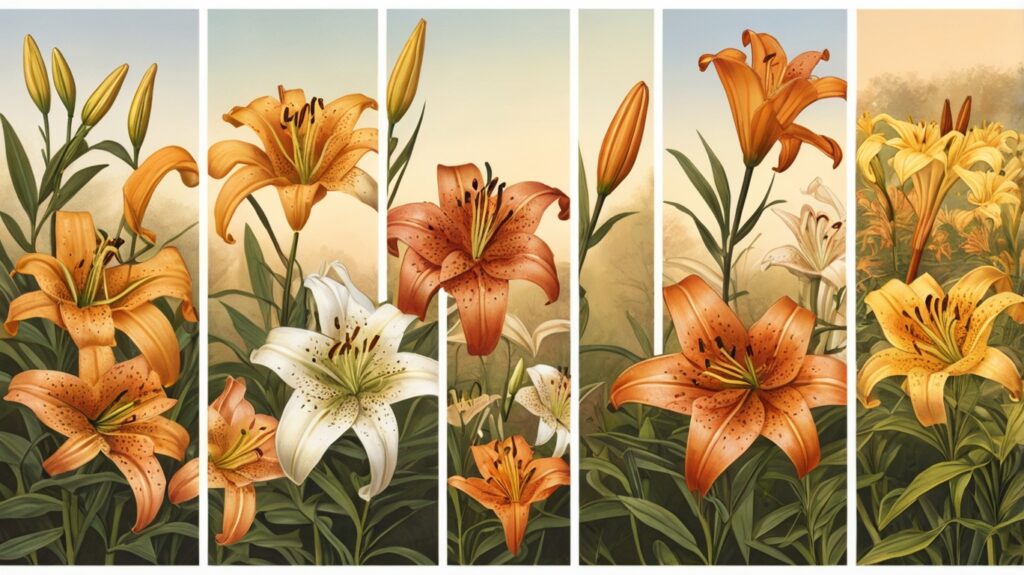
Day-Blooming vs. Night-Blooming Lilies: How Timing Impacts Bloom
Day-blooming and night-blooming lilies exhibit distinct behaviors influenced by their adaptation to environmental conditions and pollinator activity. Understanding the differences between these two categories requires a closer look at their blooming patterns and the factors driving their distinct timings.
Characteristics of Day-Blooming Lilies
Day-blooming lilies, such as water lilies in the genus Nymphaea, open their flowers during daylight hours. These lilies showcase their vibrant petals when sunlight is abundant, making them easily accessible to diurnal pollinators like bees and butterflies. The photosensitive nature of day-blooming lilies often correlates with an ability to use sunlight for optimal dependability in pollination. Their blossoms tend to close as night falls, conserving energy and protecting their delicate structures from cooler nighttime temperatures.
Day-blooming lilies thrive in environments where pollinator activity is at its peak during sunlight hours. The visual brilliance of these flowers serves as an effective strategy to attract pollinators that rely on sight rather than smell. The blooming period of these lilies can range from spring to early autumn, depending on the species and climate.
Characteristics of Night-Blooming Lilies
Night-blooming lilies, such as those in the species Nymphaea alba, take a contrasting path, opening their flowers at dusk and remaining in blossom through the nighttime hours. These lilies have evolved to cater to nocturnal pollinators, including moths and certain species of bats, by emphasizing scent-based attraction over visual cues. Their fragrances are generally more potent, enabling them to lure pollinators in the absence of daylight.
The decision to blossom at night is an ecological adaptation to limited competition for pollinators during these hours. Night-blooming lilies are essential for maintaining biodiversity in ecosystems where nocturnal pollination plays a significant role. Their blossom periods often coincide with warm, humid seasons, typically in late spring and summer.
Timing and Its Ecological Role
The timing of lily blossoms—whether day or night—directly impacts their ecological interactions and reproductive success. By aligning with their respective pollinators’ activity schedules, these lilies optimize their chances for pollination. This strategic behavior underscores the intricate relationship between flora and fauna, as well as the importance of preserving natural habitats to sustain such interactions.
Indoor vs. Outdoor Lilies: How Location Affects Bloom Cycles
Lilies grown indoors exhibit blossom cycles that differ distinctly from those of outdoor lilies due to variations in environmental conditions such as temperature, light levels, and humidity. Each location introduces unique influences that affect how and when lilies display their flowers.
Environmental Factors That Impact Indoor Lilies
Indoor lilies benefit from a controlled environment, allowing growers to manipulate conditions favorable for flowering.
- Temperature Regulation: Indoor settings enable consistent temperature control, reducing exposure to sudden fluctuations common in outdoor environments. Maintenance of optimal temperatures ensures steady growth and timely blossoms.
- Light Availability: Indoor lilies rely on supplemental light sources, such as grow lights or indirect sunlight, especially during shorter days. Adequate lighting stimulates photosynthesis and aligns their flowering cycles with desired timelines.
- Humidity Levels: Indoor humidity can be adjusted to replicate natural conditions, preventing dryness that hinders blossom development. Lily species preferring high moisture levels flourish well under these controlled settings.
Bloom Variations in Outdoor Lilies
Outdoor lilies, on the other hand, are subject to natural elements and seasonal shifts that inherently influence their blossom cycles.
- Seasonal Temperature Shifts: Exposure to outdoor temperatures, including winter dormancy periods and spring growth spurts, directly impacts blossom timing. Seasonal changes contribute to more predictable cycles aligned with nature’s rhythm.
- Access to Natural Sunlight: Unfiltered sunlight strengthens outdoor lilies, enhancing their energy reserves, which results in vibrant and robust blossoms. The duration and intensity of sunlight throughout the day dictate their flowering patterns.
- Rainfall and Moisture: Rainwater delivers nutrients often absent indoors, fostering steady growth and flower development. However, excess rainfall or drought can disrupt blooming phases.
Key Differences in Bloom Longevity and Quality
Indoor lilies sometimes blossom sooner because of controlled stimulation, but their blossoms may be shorter-lived compared to outdoor counterparts exposed to nutrient-rich soil and seasonal cycles. Conversely, outdoor lilies often demonstrate larger blooms with richer coloration, reflecting their close connection to natural factors like soil nutrients, sunlight, and rainfall.
Understanding the environmental needs of lilies in each location is crucial to fostering healthy flowering periods tailored to indoor or outdoor growth settings.
Caring for Lily Plants Year-Round to Encourage Blooming
Proper care throughout the year is essential to ensure that lily plants remain healthy and deliver thriving blossoms in their designated flowering periods. Gardeners must focus on seasonal maintenance and balanced approaches that support both growth and flowering.
Winter Care
During late fall and winter, lily bulbs enter a dormancy phase, making it a critical time to prepare them for the upcoming growing season. Protect the bulbs from freezing temperatures by insulating the soil with organic mulch or straw. For potted lilies, reposition containers indoors or to a frost-free area. Avoid watering excessively as dormant bulbs naturally require less moisture during colder months.
Spring Preparations
As temperatures start to climb and new shoots emerge, remove winter mulch to allow the plants to breathe. Regularly inspect the soil, ensuring it remains well-drained since persistently wet conditions may lead to bulb rot. Apply a balanced fertilizer rich in phosphorus to promote strong root systems and early stem growth. Begin consistent but moderate watering once sprouts appear, keeping the soil moist without over-saturation.
Summer Maintenance
Summer is the blooming period for most lily varieties. Providing full sunlight for at least six hours daily can enhance flowering potential. Avoid overhead watering to prevent fungal infections on leaves; instead, water directly at the base of each plant. Deadheading spent blooms promptly encourages the plant to focus energy on new flower production and overall vigor. Continuing light fertilization during summer ensures robust blooms and healthy foliage.
Fall Post-Bloom Care
After lilies finish flowering, leave the foliage intact to allow the plant to store energy for next season’s blooms. Avoid immediate pruning; instead, wait until stems fully yellow and wilt. Declining foliage can be cut back at ground level to prepare the bulbs for dormancy. Consider dividing overcrowded bulbs in fall to optimize growth and flowering potential in subsequent seasons.
By consistently adhering to these seasonal care practices, gardeners can promote year-round health for lily plants and foster vibrant blooms with each cycle.
Signs Your Lily Is About to Bloom and What to Expect
Lilies exhibit distinct markers signaling when they are close to blooming, allowing gardeners to anticipate the transformation from buds to fully opened flowers. Recognizing these signs can provide valuable insight into the plant’s development stage and help ensure proper care during this crucial phase.
Physical Indicators of Bud Development
As lilies approach their blooming period, buds become increasingly prominent. The growth of flower buds initially begins as small, green protrusions and gradually enlarges over time. During the maturation process, buds will typically develop a more elongated shape, and subtle changes in coloration may become evident—shifting from green to a lighter hue with hints of the flower’s eventual color showing at the tip. This stage is a clear signal that blooming is imminent.
Gradual Swelling of Buds
Another reliable indicator involves the swelling of the buds. Fully mature buds will expand and feel firm to the touch as the petals within begin to form their structure. Gardeners may observe tiny spaces forming along the seams of these buds, where the enclosed petals subtly press outward in preparation for opening.
Seasonal Timing and Temperature Effects
Timing and environmental conditions play a significant role in predicting bloom readiness. Most lily varieties bloom during their specific active season, which can range from mid-spring to late summer depending on the species. Warmer temperatures paired with adequate sunlight generally accelerate the process, while cooler conditions may delay bloom formation. Tracking seasonal patterns can help confirm whether the plant’s blooming behavior aligns with its expected cycle.
What to Expect Once Blooming Begins
Once the buds begin to open, the transitions happen relatively quickly. Within days, petals will start unfurling to reveal the intricate design and vibrant hues of the flower. In some cases, the blooms reach full maturity overnight, showcasing their complete form in the morning hours. This phase also brings heightened fragrance from certain lily varieties, enriching garden spaces with their aromatic presence.
Common Challenges with Lily Blooming and Solutions
Lilies, while celebrated for their spectacular beauty and diverse species, often face several challenges that can hinder their blooming process. Understanding these common issues and implementing effective remedies can help ensure healthy growth and vibrant flowering.
1. Incorrect Planting Depth
One of the frequent mistakes made during lily cultivation is planting bulbs too shallow or too deep. Bulbs planted too deep may struggle to emerge, while shallow planting can expose them to environmental stressors.
- Solution: Bulbs should be planted at a depth of approximately two to three times their size. For most lily species, this is generally around 4 to 6 inches below the soil surface. Ensure adequate soil coverage to protect the bulb while allowing proper emergence.
2. Overwatering or Underwatering
Improper watering may lead to root rot or dehydration, both of which can impair blooming. Lilies prefer well-drained soil but require consistent moisture during the growing season.
- Solution: Opt for a watering schedule that keeps the soil evenly moist, but not overly saturated. During active growth phases, monitor soil conditions to adjust watering frequency and use mulch to retain moisture effectively.
3. Poor Sunlight Exposure
Lilies thrive in areas with direct sunlight for at least six hours daily. Insufficient light exposure can result in weak stems, limited growth, and diminished blooms.
- Solution: Select sunny, well-lit locations for planting. If grown in partially shaded areas, supplement light conditions or consider relocating the plant to ensure optimal sunlight availability.
4. Pest Infestations
Common pests, such as aphids, lily beetles, and slugs, can damage lilies by feeding on their leaves, stems, or bulbs, thereby impacting blooming.
- Solution: Regularly inspect plants for signs of pests and apply eco-friendly insecticidal soap or neem oil as preventative measures. Introducing natural predators, like ladybugs, can also be effective in controlling pest populations.
5. Nutrient Deficiencies
Lilies require balanced fertilization to produce vibrant flowers. Lack of nutrients—particularly phosphorus, which promotes blooming—can significantly reduce flower production.
- Solution: Feed lilies with a slow-release or water-soluble fertilizer suited for flowering plants. Fertilization should be done sparingly; excess nitrogen can lead to excessive foliage growth at the expense of blooms.
6. Disease Outbreaks
Botrytis blight and basal rot are two diseases frequently affecting lilies, leading to stunted blooms and decaying plants.
- Solution: Encourage ventilation and avoid overcrowding to reduce moisture levels around the plant. Remove infected foliage promptly and treat lilies with fungicides, following the manufacturer’s guidelines.
7. Seasonal Variability
Inconsistent seasonal conditions, such as unexpected frosts or prolonged droughts, can delay flowering or damage emerging buds.
- Solution: Protect lilies from frost by covering them with burlap or frost blankets during cold snaps. During droughts, supplement irrigation to counter the lack of rainfall, ensuring lilies have access to sufficient moisture.
Addressing these common challenges proactively can significantly improve the likelihood of a successful lily bloom season.
How to Prolong the Blooming Period of Lilies in Your Garden
To extend the blooming period of lilies, it is essential to implement proper care practices and create favorable growing conditions. Lilies thrive when given the right balance of nutrients, light, and attention during their active season. By following these guidelines, gardeners can enjoy the elegant blooms of lilies for a longer period.
- Choose the Right Varieties Different lily species and hybrids bloom at varying times, with some blooming early in the season and others later. Planting a mix of early, mid-season, and late-blooming varieties can naturally extend the display of flowers. For instance, Asiatic lilies typically bloom in early summer, while Oriental lilies bloom toward midsummer.
- Deadhead Faded Flowers Promptly Removing spent blooms, known as deadheading, prevents lilies from producing seeds. This practice helps direct the plant’s energy back into bulb development and encourages a longer flowering phase.
- Ensure Proper Watering Consistent watering is crucial during the blooming period. Overwatering or allowing soil to dry out can stress the plant, leading to shorter bloom times. Water lilies deeply but avoid soggy conditions by ensuring the soil is well-drained.
- Provide Adequate Fertilization Feeding lilies with a balanced, slow-release fertilizer or a liquid feed high in potassium supports healthy blooms. Fertilize during the growing season, especially before and after the flowering period, to enhance their vigor.
- Protect Against Pests and Diseases Lilies are vulnerable to pests like aphids and diseases like botrytis blight. Regular monitoring and proactive treatment with suitable organic or chemical controls prevent damage, ensuring prolonged flowering.
- Mulch to Retain Soil Moisture Applying mulch around the base of lilies helps in maintaining consistent soil moisture while reducing temperature fluctuations. This encourages steady growth and prolonged blooms.
- Provide Adequate Sunlight Lilies perform best in full sun or partial shade, depending on the variety. Ensuring the plants receive a minimum of six hours of sunlight daily optimizes their blooming potential. If shaded too much, flowering might decrease or shorten.
- Stake Tall Varieties To prevent damage due to wind or rain, tall lily varieties often require staking. Supporting the stems aids in keeping the blooms upright and vibrant for an extended period.
Cultivating lilies with care and attention to these details ensures not only a longer display of vivid blooms but also healthier, more enduring plants for seasons to come.

Conclusion: Optimal Care Tips for Ensuring Lily Blooms Seasonally
Ensuring lilies bloom seasonally requires attention to specific care practices tailored to their growth cycle and environmental needs. Lilies, as perennials, depend on consistent nurturing to thrive, whether planted in gardens or containers. Understanding their preferences for soil, sunlight, and watering ensures optimal blooming conditions each year.
Key Guidelines for Caring for Lilies:
- Soil Preferences: Lilies thrive in soil that is well-draining and rich in organic matter. Testing the pH level ensures it remains slightly acidic to neutral, typically within the 6.0 to 7.0 range. Incorporating compost or aged manure can enhance soil quality and nutrient availability.
- Sunlight Needs: Most lily varieties require full sun exposure to promote vigorous growth and vibrant blooms. Ensuring they receive at least six to eight hours of direct sunlight daily is critical, although some species, like martagon lilies, may tolerate light shade.
- Watering Practices: Lilies need consistent moisture during their growing season but are sensitive to overwatering. It is essential to keep the soil evenly moist without allowing water to pool. During dormant periods, reduce watering to prevent bulb rot.
Additional Considerations:
- Mulching: Applying mulch around lily plants can help retain soil moisture, regulate temperature, and prevent weed growth. Organic mulch such as wood chips or straw is particularly beneficial.
- Fertilization: Using a balanced fertilizer during the active growing season can boost blooms. A slow-release fertilizer applied during spring supports healthy development.
- Deadheading Spent Blooms: Removing wilted blooms encourages the plant to focus on new flower production rather than seed formation, thereby extending the flowering period.
- Winter Protection: In colder climates, ensure bulbs are protected by layering mulch or relocating potted lilies indoors. Adequate insulation prevents frost damage.
Proper care not only ensures seasonal blooms but also enhances the longevity of lilies, keeping them healthy for years. Structured maintenance with attention to their specific needs is the cornerstone of fostering vibrant and reliable seasonal flowering.




